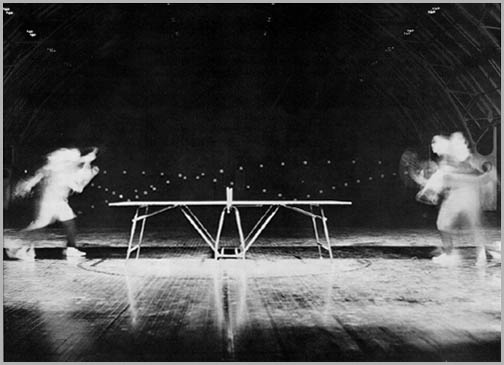|
I still remember my first encounters with balls made from
these two different kinds of rubber. My father gave me a superball. It looked
ordinary, black and hard, but when I dropped it I was startled as it bounced
nearly back into my hand. I spent hours bouncing the superball into corners
and off the kitchen floor into the bottom of a table.
Recently one of my students handed me a ball that looked
like a superball, and stood by, quietly smiling. I tossed the ball onto
the floor, and it stopped dead. I was stunned. I had just been handed an
anti-superball, a "no-bounce ball." After hours of experimenting,
I found that the no-bounce ball does return to its original shape, but too
slowly to bounce off the floor. The no-bounce ball is made from a polymer
called
norbonene
, which converts the organized energy of motion into
thermal energy.

|
|
Balls are specifically designed for a particular sport.
They are suited to the games that we play with them. A change in the bounciness
of a ball can drastically affect a game.
|
|
Hot Bounce
Baseball legend tells of managers preparing for the arrival
of a visiting team full of home-run hitters by placing baseballs in the
freezer for several hours to alter their bounce. You can try this yourself.
Take two identical baseballs, freeze one, and then compare the bounciness
of the two balls. Experiment with other kinds of balls, comparing a cold
ball to a warm one.
We found that frozen baseballs did not bounce as high as warm ones. We continued
our research with golf balls and found that frozen golf balls are also less
bouncy. (If you play golf in the winter, you'll hit the ball farther if
you keep it warm in your pocket.) A cold superball bounces less than a warm
one. Generally, cold balls are less bouncy than warm ones. That's because
cold rubber is generally not as flexible as warm rubber. When a cold ball
hits the floor, the deformation that follows the collision is concentrated
at the bottom of the ball. This concentrated deformation causes the rubber
molecules to collide with each other, producing warmth rather than rebound.
The one exception is the no-bounce ball. A cold no-bounce
ball actually bounces better than a room-temperature one. The stiff, cold,
norbonene polymer does not deform as much to dissipate the energy of the
ball.
A Bored Tennis Ball
Basketballs, tennis balls, footballs, and many other balls
take advantage of the springiness of air. If you compress a closed container
of air--a balloon, for example--it will spring back into shape as soon as
you release it. An air-filled ball is lighter than a solid rubber one, and
that condition
has certain advantages. If you made a solid rubber tennis
ball with the same bounciness as an airfilled one, the mass of the ball
would exert damagingly large forces on the forearms of tennis players. The
very thought of a solid rubber volleyball makes my fingers ache.
Air-filled tennis balls bounce well. However, you can take
the bounce out of a tennis ball just by boring a few holes into the ball.
Use a soldering iron to melt a few holes into a tennis ball, then compare
the bounce of the bored ball to that of a normal tennis ball. When the bored
ball bounces, air is compressed and forced out through the holes. Only a
portion of the air remains inside the ventilated ball. When this air expands,
only a fraction of the original energy is returned to the ball, so the ball
does not bounce very well.
If I had known about this back when I was a kid, I could
have made our baseball game more interesting by boring some holes in the
tennis ball. Then maybe the ball wouldn't have been lost in the woods after
the first hit.
|
"That's The Way the Ball Bounces" originally appeared in the Sports
Issue of
Exploring Magazine
in 1991.
|
|
To return to Sport! Science click Continue.
|
|